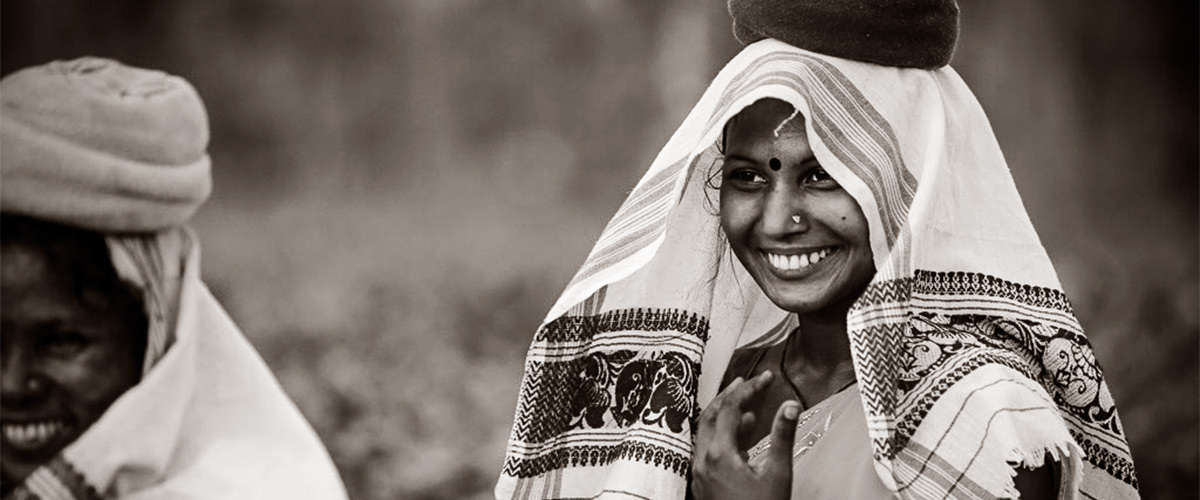In my family, for many generations we’ve been ordering our wedding Mekhala Chadors from weavers in Sualkuchi, Assam famous for its silk weaving. A car full of female relatives sets off from Guwahati, on an hour’s drive across the Brahmaputra to Sualkuchi to meet the traders, see their looms, decide patterns, colours and of course, haggle prices, all done over several cups of ‘lal cha’ (a light brew where the tea leaf is added to hot water and poured out immediately without adding milk).
For my wedding I choose a stylised design of a tree with large flowers, in natural Muga colour with gold threads for the thread work. I wear it occasionally and receive a lot of compliments for it. I love attending a day time Assamese wedding, where most of the women dress up in Muga or white silk Mekhla Chadors with the design woven in various pastel colour threads and a hint of zari here and there. They make for a classic image of timeless elegance. Muga is a type of wild silk yarn that is hand spun. It is of a dull gold colour and is found only in regions of Assam and Bihar.
My ‘aita’ (Assamese for grandmother) felt a bit of red in my wedding attire, would have made it look richer and more festive. She was an accomplished weaver and used a back strap loom. She would trace patterns on a graph paper from old ‘Women & Home” magazines that visiting relatives would bear as gifts, and go on to create a design that could translate into a weave on her loom.

As a young child growing up in a tea garden in Assam, holidays were always spent with aita. I would stay with her and help her spin yarn. The back strap looms are the first I ever encountered and have a special place in my heart. The loom is simple in construction and easy to operate. However, I confess, I never quite managed to learn how to translate a design on the loom…I lacked the patience that was required. Aita was quite critical of my tracing skills and hence, my skills on a back strap loom are very basic. She is the last member in our family to have skillfully woven on a back strap loom.
My memories are of aita weaving on the loom, while she narrated stories, some about her own childhood, of an aunt from whom she learnt to weave. At other times, the tales were from the Ramayan or Mahabharata that usually ended with a moral. Naturally I preferred the stories from her own past as these always included a little gossip about some relative or the other, who had displeased my grandmother.
Back in the day, the women of my grandmother’s generation wove at home, even in the semi urban towns and cities of Assam. It was an essential skill taught to a girl just as cooking was. A girl was considered a good match if she was an accomplished weaver and could cook a sumptuous fish curry for the Bihu feast. Every household had looms and it was a way of life. Once the women folk finish their daily cooking and cleaning in and around their huts, they would sit down to weave.

Often, these looms were set up outside the house, as it allowed them to keep an eye on their children and the livestock. Homes that had more than one weaver, set up looms together. These women happily went across to each others yards, to discuss colours or to help another to set up her loom.
Even now in the villages, especially among the Bodo and Mishing tribes, weaving is a part of the lifestyle. The weavers use cotton yarn and weave their own clothes – strips with a long design in the middle that are later joined to form a sarong called Gale or Mekhla, a wrap with small motifs in it to form the Chador or Gabu, and a thinner cloth with a small pattern running across both ends known as Gamosa are usually woven.
The looms provide the weaver flexibility in introducing colours, and the brilliant hues that the women use in their weaving give the pieces so much vitality and warmth. These women weave for their own pleasure and are not restricted to meet the demands of a fickle market.
 Natural yarns like Muga and hand weaving have both featured extensively in my creations. Even today, after having spend 20 odd years in the textile industry, I am awed by the patterns produced by these women on their primitive looms. It is this bold mix of colours and in dazzling combinations that have most influenced my aesthetic sensibility and continues to be reflected in my own work.
Natural yarns like Muga and hand weaving have both featured extensively in my creations. Even today, after having spend 20 odd years in the textile industry, I am awed by the patterns produced by these women on their primitive looms. It is this bold mix of colours and in dazzling combinations that have most influenced my aesthetic sensibility and continues to be reflected in my own work.
Featured banner shows a tea plucker in Assam, wearing the gamosa. Photograph by Gautam Virprashad.
Inset photographs, courtesy author

